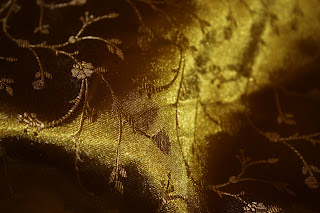I was lost, but found again. I've actually been working on quite a few projects and just about to start a big one for the summer.
In October 2011, I participated in the The Realm of Venus' first Mini-Challenge: the
'Idle Hands' challenge. I made a 16th century style fan flag, inspired by extant fans (image from Hartwood Castle website).
I chose to creat a flag fan--ventuolo--made of perforated parchment and gilded wood. I first researched flag fans, fairly easy due to the many wonderful sites with information about the Venetian 16th century accessories. It seems that flag fans could be made of fabric, parchment, or woven of ribbons or plant fibers. I chose parchment as I loved the perforated extant example. I wanted to do a finer perforation as I have a tool for that already. I thought the breeze created might be better without larger holes in the flag, too.
 I acquired real parchment made of sheepskin. The pieces were lovely golden and had a texture that was unique unlike what you would find with faux paper parchment. The parchment was also thicker than paper, although still quite easy to punch through.
I acquired real parchment made of sheepskin. The pieces were lovely golden and had a texture that was unique unlike what you would find with faux paper parchment. The parchment was also thicker than paper, although still quite easy to punch through.
 My perforation tool is very modern - as you can see in the picture - but fairly straight forward. Perhaps one day I will make one that might have been used in the 16th century. The design is created by pushing the pin through the parchment at regular intervals.
My perforation tool is very modern - as you can see in the picture - but fairly straight forward. Perhaps one day I will make one that might have been used in the 16th century. The design is created by pushing the pin through the parchment at regular intervals.
As you can see, the design is hard to photograph due to the small holes, but hopefully the lattice pattern comes out. The slightly blurry close-up, I took a picture without the flash so that backlight could (possibly) shine through some of the holes.
Here's the other side of the flag.
I used wooden molding for the handle, gluing the parchment edge in between two pieces. After sanding the wood, particularly where the pieces met and the ends, I used 18k gold paint to gild the handle. I used the same paint to decorate the parchment a little bit.
Perhaps not as fancy as some, definitely not as intricate as others, but it is my real parchment perforated flag fan!
References
Realm of Venus http://realmofvenus.renaissanceitaly.net/
The Anéa Costumes http://www.aneafiles.webs.com/index.htm
Festive Attyre http://www.festiveattyre.com/
Oonaghs' Own http://webspace.webring.com/people/lo/oonaghsown/curves/fans_in_portraits.htm
Katerina’s Stuff http://katerina.purplefiles.net/FlorenceFiles/FLAccessoriesFAN.html
Lady Dianotto's Costume in Renaissance http://www.ladydianottos.com
 I
am tied between using linen or silk for the underskirt, both of which I have in
my stash. It won’t show, at least not much, but I might want to use it when it
would show. The linen is turquoise and the silk is a shiny gold. The former
would sort of blend whereas the latter would go with the trim. Both would be
cool, but the linen would probably hold up better….
I
am tied between using linen or silk for the underskirt, both of which I have in
my stash. It won’t show, at least not much, but I might want to use it when it
would show. The linen is turquoise and the silk is a shiny gold. The former
would sort of blend whereas the latter would go with the trim. Both would be
cool, but the linen would probably hold up better…. Ok,
after a lot of debate, I’ve cut the beautiful gold silk from my stash. I have
been saving that material for so long it was tough to cut into it! I allowed 4
yards for the skirt. There is a decorative edging that I would like to preserve
so I will need to be careful cutting the waistband.
Ok,
after a lot of debate, I’ve cut the beautiful gold silk from my stash. I have
been saving that material for so long it was tough to cut into it! I allowed 4
yards for the skirt. There is a decorative edging that I would like to preserve
so I will need to be careful cutting the waistband. This
material is a fraying mess! I cut off one edge and set aside for the waistband.
I sewed the ends together for the skirt seam, double it over to control the
fraying.
This
material is a fraying mess! I cut off one edge and set aside for the waistband.
I sewed the ends together for the skirt seam, double it over to control the
fraying. I left about 6” at the top for a closure,
rolling the edges with a hem stitch. I think I will do a box pleat to attach to
the waistband, but I need to hang it first.
I left about 6” at the top for a closure,
rolling the edges with a hem stitch. I think I will do a box pleat to attach to
the waistband, but I need to hang it first. 



























